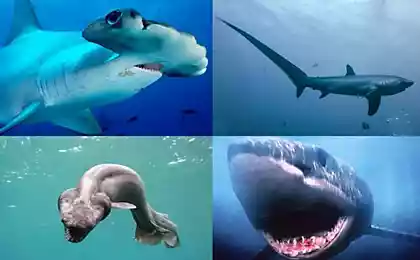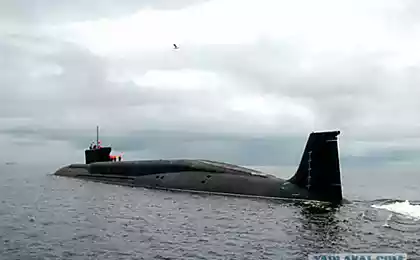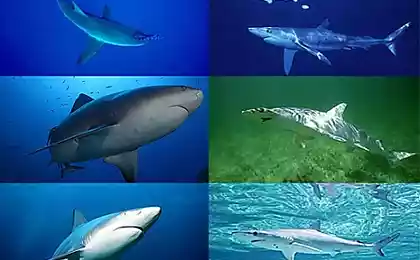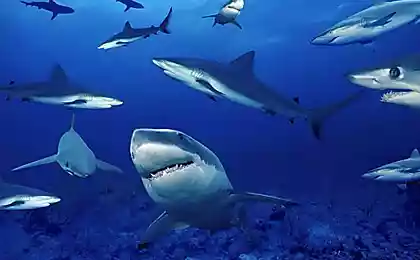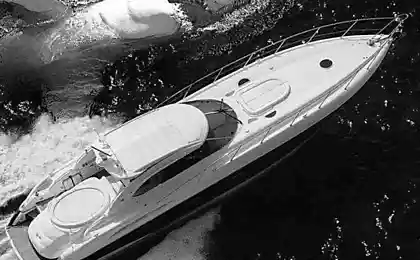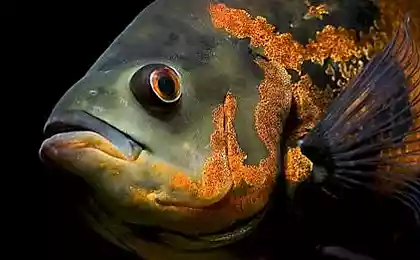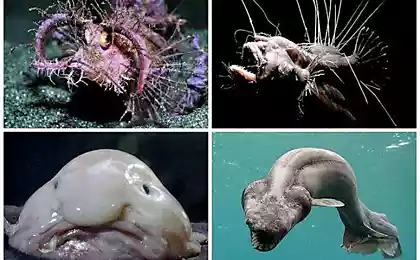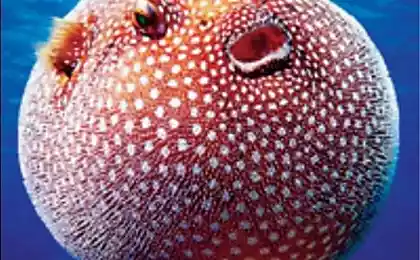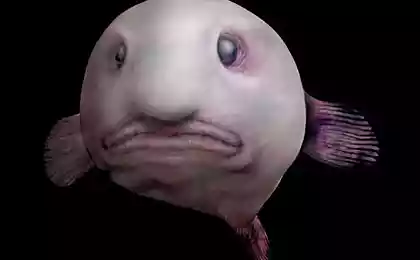16011
Frilled shark - a living fossil (16 photos + video)
Frilled shark is a dangerous creature, originally from the Cretaceous period. This predator is one of the first places in the ranking of the most interesting fish.
Unlike other species, during its existence, it has not evolved. And that is why it is called a living fossil.
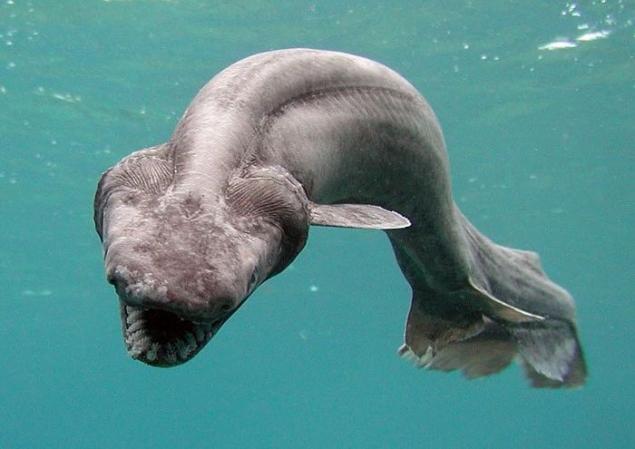
The name of this ancient animal received for the serpentine shape of a long, almost 2 meter brown body and folded skin that covers the gill openings. Gill membranes, crossing at the throat to form a bag of skin that resembles a raincoat. Century in this species is not, and is not divided into the spine vertebrae, which once again proves frilled primitive fish. All fins are located nearby, and the tail fin consists of only one blade. Plaschenostsa jaws - his private pride. Firstly, the mouth is not located on the underside of the snout portion, and on its end portion. Hooked teeth, five-pointed, comb, a little reminiscent of the crown, and is not typical of sharks sequence - small front and rear are bigger. Only about 300 of the jaw sharp teeth. In appearance they resemble sharks or sea snake eel more than usual sharks.
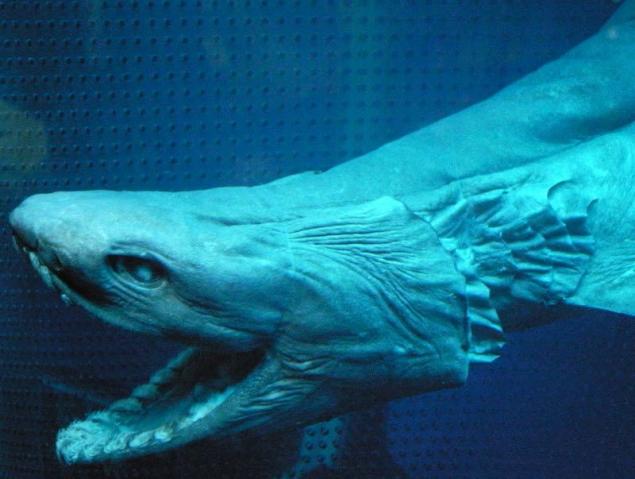
This kind of shark was described in 1884 by the American zoologist Samuel Garmanov. Chlamydoselachus anguineus name comes from the Greek χλαμύς - «cloak" and σέλαχος - «Shark" and the Latin anguineus - «snake-like." For a long time this shark was considered a single view of his family and clan. Then, referring to add a second in 2009 - Chlamydoselachus africana. Prehistoric monster prefers the warm waters of the Atlantic Ocean, the tropics, however, were seen in the Barents Sea near Norway. Only recently received information that this type is capable of vertical migration - when the temperature changes or lack of food fish chimera close to the surface.
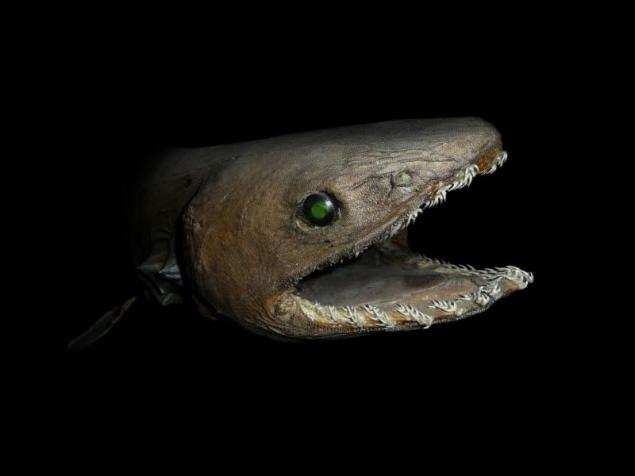
This ancient animals are two major titles - Frilled shark, which she received for having a body kind of placenta brown, resembling a cape. The second name - corrugated shark. This name it owes numerous folds of skin on the body. Such a kind of creases on her skin, according to scientists, - a reserve volume of the body to accommodate large prey in the stomach. After Frilled shark swallows its prey, mostly, as a whole, because the needle-shaped, curved jaws inside vershinki her teeth are not able to crush and grind food. But they hold great slippery prey in the mouth and do not give it to escape from the jaws. Frilled shark lives in the bottom layer of water of all oceans except the Arctic. Very rarely, some individuals are found at a depth of less than 200 meters - this is a typical deep-sea predator. Maybe she has survived only because in the depths of the ocean she has no worthy rivals and enemies. Attacks plaschenosets contracting, and then, abruptly firing the entire body like a snake, and long jaws with leather folds allows you to capture all the prey whole. Chlamydoselachus can swallow the victim in half its length. In addition, they create negative pressure by closing the gills, and the hapless victims sucked directly into the womb. Body found serpentine predators were not allowed to identify the contents of your stomach that says anything about the large gaps between meals, or about the rapid pace of digestion.

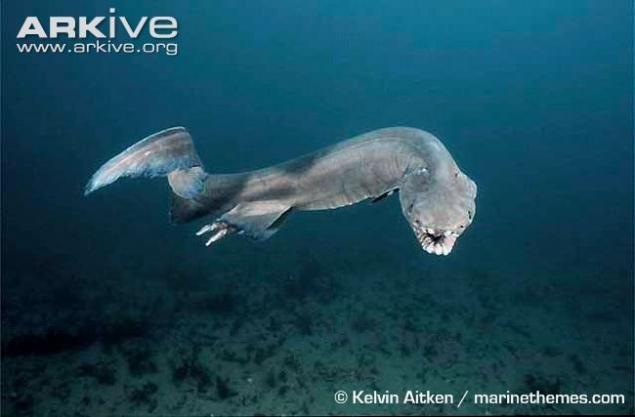

It feeds on fish and cephalopods. Based on the study of stomach contents to catch Chlamydoselachus, scientists have concluded that the squid make up almost 60% of the diet of these predators. And they ingest these cephalopods entirely. And once in the stomach Chlamydoselachus even found the remains of the cat sharks, the length of which was 40% of body length to swallow its predator. Gill jumper almost merge in the throat sharks, forming a collar that resembles a kind of frill. Nictitating membrane in Chlamydoselachus absent. An interesting feature of proving the primitiveness of these villages (or, as they are called - klamidoselahy) - an open sideline. The receptors are located on the skin in particular its groove and covered with a gelatinous liquid as the remaining fish, interacting directly with the environment. Fins plaschenostsev strongly shifted back, except infants. Dorsal fin single, located on the fin. Caudal atrophied lower blade and a well-developed upper. Frilled shark is viviparous. Pregnant females lasts about 2 years, and register up to 3, 5 years, and after 2-3 independent ugrevidnye born baby. Gestation period in this species the largest of all vertebrates. Newborn Akulenok prehistoric shark has a length of about 50 cm. In ancient times, prehistoric sharks patrolling the deep waters, raising fears in there the inhabitants. But now relict crumbs do not concede their right to leadership in the world's oceans - it's hard to find the animal a stronger and more powerful than Frilled shark.
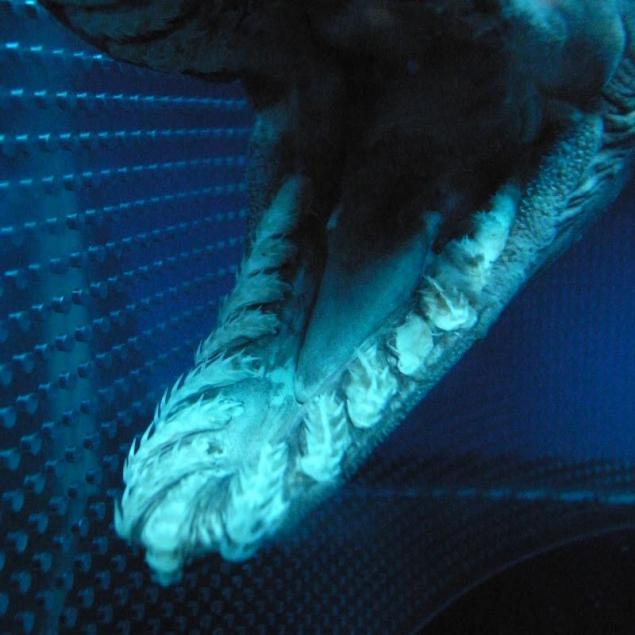
This kind of poorly understood. Recorded only a few cases where plaschenostsa getting out of the water alive. The last of them - in 2007, when Japanese researchers lucky enough to not only see the risen from the depths of the monster, but to shoot him. Unfortunately, the big fish soon died, apparently having some sort of disease. In another case, frilled shark interested blades bathyscaphe plying across the ocean floor near the Black Continent. She was accompanied by several hours underwater machine, and then swam away. Mouth frilled Cougar is not located on the lower part of the head, like all "normal" sharks, and at the tip of the snout. Teeth have a flat base with numerous shiloobraznymi apex curved inward jaws predator. Typically each tooth are three longer vershinki and many smaller ones. Just jaws plaschenostsa from 40 to 57 teeth with such hook-and acute apex. Another feature of these villages, issuing their backlog from actively evolved species of sharks - is pivotally attached to the lower jaw of the skull. In fairness, it should be noted that the lower mobility of this design have plaschenostsev more than compensated by the huge size of the jaws, allowing "cram" into the esophagus large prey. Eyes Chlamydoselachus relatively large, oval. The uniqueness of this sensory organ predator is the ability to glow in the dark depths, where she spends most of his life. Remove from the water and killing the shark quickly loses luster and greenish glow of their eyes. As befits mnogozhaberniku, the glorious detachment which belongs to the frilled shark, it has six pairs of gill slits. Female Chlamydoselachus can reach two meters long, the male - 170 cm, but the usual size of these fish do not exceed one and a half meters.
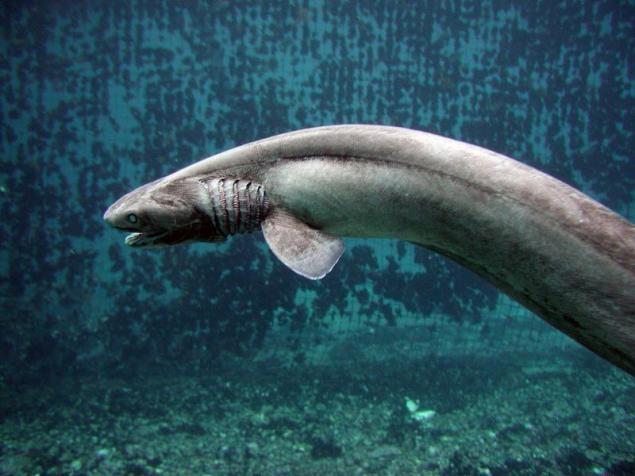
Plaschenostsev often caught in a moderately warmer and warmer latitudes. Many cases have occurred in the capture of the Japanese islands, Taiwan, Brazil, Australia and New Zealand. However, there were also cases of catching these wonderful fish and higher - even off the coast of the Scandinavian Peninsula, off the coast of Norway. The boundaries of the area of this predator have not been studied, it is possible she could live in the northern seas or near Antarctica. After at considerable depth and in tropical seas, such as the Arctic seas have a difference in water temperature as the surface. This predator is a bottom lifestyle, preferring depths from 400 to 1500 meters, and feeds mainly cephalopods, bony fish and benthic crustaceans. Not refuse to diversify the menu small sharks or stingrays. It is assumed that klamidoselahii are capable of vertical diurnal migration, rising in the dark near the sea surface. During the day they are placed in the back. Foraging busy all day, but are very active at night. Since the fins of sharks do not allow to develop her cruising speed, inherent, for example, mako, its main tactics of attacks similar to that of snakes. Frilled shark like catapulting her body with wide-open mouth in the direction of production and captures it in a trap of their jaws. Before the attack, she can sway some time in the water, resting on the ground tail fin. Such movements fascinate and attract prey closer. Can they, like many demersal sharks use to capture food "buccal" pump. At the same time they close the gill slits kind of valves and suck the victim or a piece of food in his mouth. Good bait for a successful hunt and glowing eyes are these sharks.
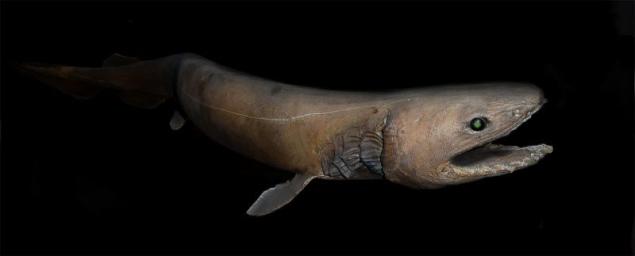
Many millions of years ago klamidoselahii patrolled deep water, raising fears in there the inhabitants. But nowadays relic sharks do not want to cede the right to leadership in the world's oceans - at a depth of more than half a kilometer is difficult to find the animal a stronger and more powerful than Frilled shark. For obvious reasons, this kind of poorly understood. Recorded only a few cases where plaschenostsev getting out of the water alive. Last occurred in 2007, when Japanese researchers lucky enough to not only see the risen from the depths of the monster, but also to photograph it. Unfortunately, the big fish soon died. Perhaps, from the depths to the surface of the sea it forced up the disease and foreboding demise. This world of aquatic animals often happens - on the surface float and dying Krakow - monstrous squid in existence for a long time refused to believe the scientific world.
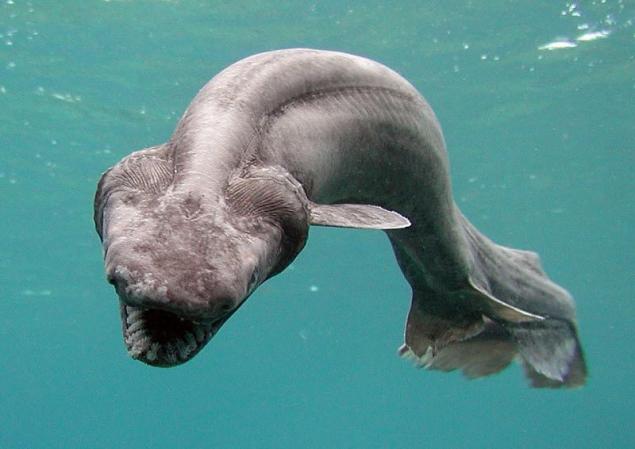
In another case, frilled shark interested blades bathyscaphe plying across the ocean floor near the African continent. She was accompanied by a few hours of deep-water apparatus, showing off in front of portholes with scientists clung to them, and then disappeared into the dark abyss. It should be noted that at present there are two known types of klamidoselahy - ordinary frilled and South African frilled shark, which was described as a separate species, more recently - in 2009. South African frilled shark found off the coast of South Africa. They were caught in the coastal waters of Namibia, England, South Africa. From conventional Chlamydoselachus they are more broad head and mouth, the proportions in the arrangement of fins on the body. Anatomical differences are enclosed in number of turns of the spiral valve of the stomach and the number of vertebral axial skeleton. We can assume that in the depths of the world's oceans are hidden from human eyes and other klamidoselahy. Oceanic "bosom" and their inhabitants studied much less than I would like.

Today plaschenostsy, due to its extraordinary rarity not have any commercial value. However, the sharp teeth repeatedly suffered fishermen - mnogozhabernye giant fish just tearing teeth raised shrimp benthic network. The increase of cases Chlamydoselachus meetings with people lately, and researchers assert that reason - not to increase the number of the latter, and in raising the temperature waters of the world. At the bottom is too little air, and prehistoric predators simply begin to look for a new convenient refuge. Not disappeared, and has not changed for thousands of years, it is likely that Chlamydoselachus soon regain power over the oceans and on the right will be considered as the most advanced inhabitants of the dark depths of the sea.
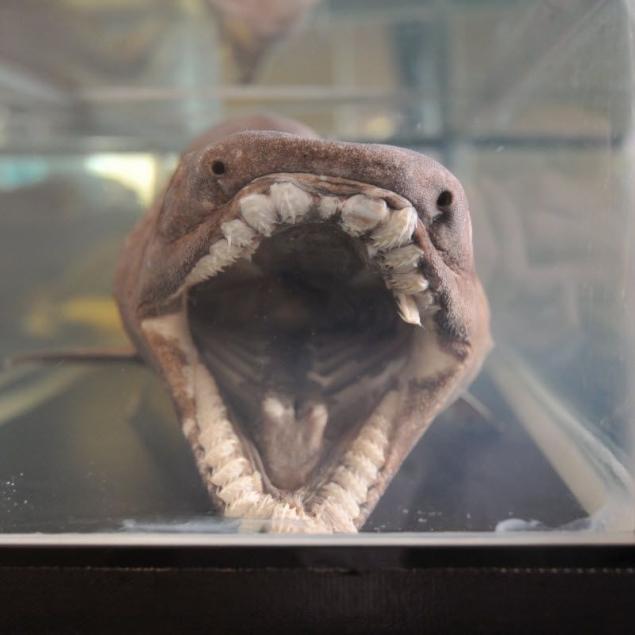
So in 2012, the network of Murmansk fishermen caught "historical catch." Fishermen pulled from the waters of the Barents Sea Chlamydoselachus - only dozhivshuyu to the present day representatives of the oldest species of sharks.
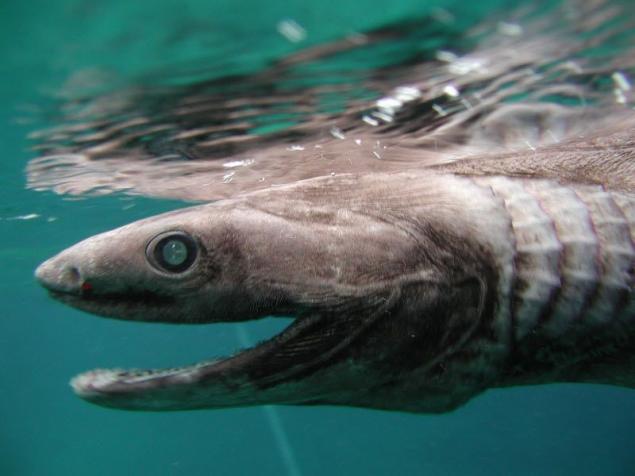
These fish are not dangerous to humans, and most of them had never seen.

If caught Chlamydoselachus known in many areas located in the subtropical and temperate warm-water zone. In the Atlantic, it caught off the coast of the South-West and North Africa and Europe. This shark was also noted in the waters of South America, Australia, Japan and California.
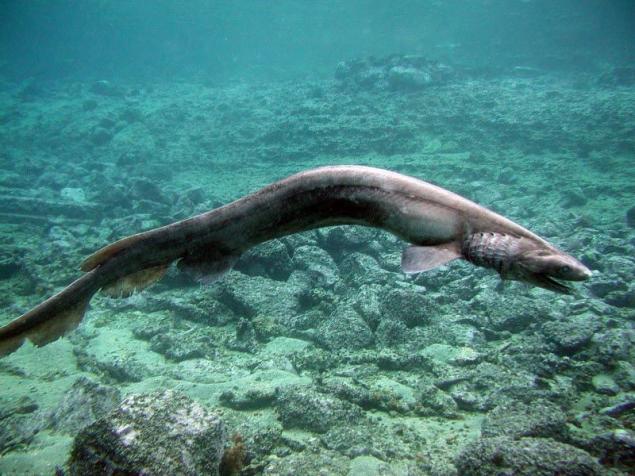
Superorder: Sharks squad: Hexanchiformes Family: Chlamydoselachus Gender: Chlamydoselachus View: Frilled shark
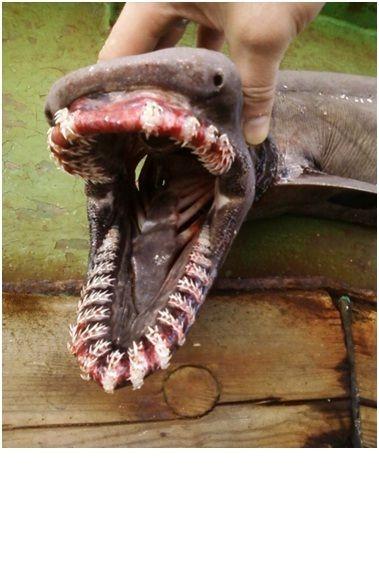
Source: bigpicture.ru
Unlike other species, during its existence, it has not evolved. And that is why it is called a living fossil.

The name of this ancient animal received for the serpentine shape of a long, almost 2 meter brown body and folded skin that covers the gill openings. Gill membranes, crossing at the throat to form a bag of skin that resembles a raincoat. Century in this species is not, and is not divided into the spine vertebrae, which once again proves frilled primitive fish. All fins are located nearby, and the tail fin consists of only one blade. Plaschenostsa jaws - his private pride. Firstly, the mouth is not located on the underside of the snout portion, and on its end portion. Hooked teeth, five-pointed, comb, a little reminiscent of the crown, and is not typical of sharks sequence - small front and rear are bigger. Only about 300 of the jaw sharp teeth. In appearance they resemble sharks or sea snake eel more than usual sharks.

This kind of shark was described in 1884 by the American zoologist Samuel Garmanov. Chlamydoselachus anguineus name comes from the Greek χλαμύς - «cloak" and σέλαχος - «Shark" and the Latin anguineus - «snake-like." For a long time this shark was considered a single view of his family and clan. Then, referring to add a second in 2009 - Chlamydoselachus africana. Prehistoric monster prefers the warm waters of the Atlantic Ocean, the tropics, however, were seen in the Barents Sea near Norway. Only recently received information that this type is capable of vertical migration - when the temperature changes or lack of food fish chimera close to the surface.

This ancient animals are two major titles - Frilled shark, which she received for having a body kind of placenta brown, resembling a cape. The second name - corrugated shark. This name it owes numerous folds of skin on the body. Such a kind of creases on her skin, according to scientists, - a reserve volume of the body to accommodate large prey in the stomach. After Frilled shark swallows its prey, mostly, as a whole, because the needle-shaped, curved jaws inside vershinki her teeth are not able to crush and grind food. But they hold great slippery prey in the mouth and do not give it to escape from the jaws. Frilled shark lives in the bottom layer of water of all oceans except the Arctic. Very rarely, some individuals are found at a depth of less than 200 meters - this is a typical deep-sea predator. Maybe she has survived only because in the depths of the ocean she has no worthy rivals and enemies. Attacks plaschenosets contracting, and then, abruptly firing the entire body like a snake, and long jaws with leather folds allows you to capture all the prey whole. Chlamydoselachus can swallow the victim in half its length. In addition, they create negative pressure by closing the gills, and the hapless victims sucked directly into the womb. Body found serpentine predators were not allowed to identify the contents of your stomach that says anything about the large gaps between meals, or about the rapid pace of digestion.



It feeds on fish and cephalopods. Based on the study of stomach contents to catch Chlamydoselachus, scientists have concluded that the squid make up almost 60% of the diet of these predators. And they ingest these cephalopods entirely. And once in the stomach Chlamydoselachus even found the remains of the cat sharks, the length of which was 40% of body length to swallow its predator. Gill jumper almost merge in the throat sharks, forming a collar that resembles a kind of frill. Nictitating membrane in Chlamydoselachus absent. An interesting feature of proving the primitiveness of these villages (or, as they are called - klamidoselahy) - an open sideline. The receptors are located on the skin in particular its groove and covered with a gelatinous liquid as the remaining fish, interacting directly with the environment. Fins plaschenostsev strongly shifted back, except infants. Dorsal fin single, located on the fin. Caudal atrophied lower blade and a well-developed upper. Frilled shark is viviparous. Pregnant females lasts about 2 years, and register up to 3, 5 years, and after 2-3 independent ugrevidnye born baby. Gestation period in this species the largest of all vertebrates. Newborn Akulenok prehistoric shark has a length of about 50 cm. In ancient times, prehistoric sharks patrolling the deep waters, raising fears in there the inhabitants. But now relict crumbs do not concede their right to leadership in the world's oceans - it's hard to find the animal a stronger and more powerful than Frilled shark.

This kind of poorly understood. Recorded only a few cases where plaschenostsa getting out of the water alive. The last of them - in 2007, when Japanese researchers lucky enough to not only see the risen from the depths of the monster, but to shoot him. Unfortunately, the big fish soon died, apparently having some sort of disease. In another case, frilled shark interested blades bathyscaphe plying across the ocean floor near the Black Continent. She was accompanied by several hours underwater machine, and then swam away. Mouth frilled Cougar is not located on the lower part of the head, like all "normal" sharks, and at the tip of the snout. Teeth have a flat base with numerous shiloobraznymi apex curved inward jaws predator. Typically each tooth are three longer vershinki and many smaller ones. Just jaws plaschenostsa from 40 to 57 teeth with such hook-and acute apex. Another feature of these villages, issuing their backlog from actively evolved species of sharks - is pivotally attached to the lower jaw of the skull. In fairness, it should be noted that the lower mobility of this design have plaschenostsev more than compensated by the huge size of the jaws, allowing "cram" into the esophagus large prey. Eyes Chlamydoselachus relatively large, oval. The uniqueness of this sensory organ predator is the ability to glow in the dark depths, where she spends most of his life. Remove from the water and killing the shark quickly loses luster and greenish glow of their eyes. As befits mnogozhaberniku, the glorious detachment which belongs to the frilled shark, it has six pairs of gill slits. Female Chlamydoselachus can reach two meters long, the male - 170 cm, but the usual size of these fish do not exceed one and a half meters.

Plaschenostsev often caught in a moderately warmer and warmer latitudes. Many cases have occurred in the capture of the Japanese islands, Taiwan, Brazil, Australia and New Zealand. However, there were also cases of catching these wonderful fish and higher - even off the coast of the Scandinavian Peninsula, off the coast of Norway. The boundaries of the area of this predator have not been studied, it is possible she could live in the northern seas or near Antarctica. After at considerable depth and in tropical seas, such as the Arctic seas have a difference in water temperature as the surface. This predator is a bottom lifestyle, preferring depths from 400 to 1500 meters, and feeds mainly cephalopods, bony fish and benthic crustaceans. Not refuse to diversify the menu small sharks or stingrays. It is assumed that klamidoselahii are capable of vertical diurnal migration, rising in the dark near the sea surface. During the day they are placed in the back. Foraging busy all day, but are very active at night. Since the fins of sharks do not allow to develop her cruising speed, inherent, for example, mako, its main tactics of attacks similar to that of snakes. Frilled shark like catapulting her body with wide-open mouth in the direction of production and captures it in a trap of their jaws. Before the attack, she can sway some time in the water, resting on the ground tail fin. Such movements fascinate and attract prey closer. Can they, like many demersal sharks use to capture food "buccal" pump. At the same time they close the gill slits kind of valves and suck the victim or a piece of food in his mouth. Good bait for a successful hunt and glowing eyes are these sharks.

Many millions of years ago klamidoselahii patrolled deep water, raising fears in there the inhabitants. But nowadays relic sharks do not want to cede the right to leadership in the world's oceans - at a depth of more than half a kilometer is difficult to find the animal a stronger and more powerful than Frilled shark. For obvious reasons, this kind of poorly understood. Recorded only a few cases where plaschenostsev getting out of the water alive. Last occurred in 2007, when Japanese researchers lucky enough to not only see the risen from the depths of the monster, but also to photograph it. Unfortunately, the big fish soon died. Perhaps, from the depths to the surface of the sea it forced up the disease and foreboding demise. This world of aquatic animals often happens - on the surface float and dying Krakow - monstrous squid in existence for a long time refused to believe the scientific world.

In another case, frilled shark interested blades bathyscaphe plying across the ocean floor near the African continent. She was accompanied by a few hours of deep-water apparatus, showing off in front of portholes with scientists clung to them, and then disappeared into the dark abyss. It should be noted that at present there are two known types of klamidoselahy - ordinary frilled and South African frilled shark, which was described as a separate species, more recently - in 2009. South African frilled shark found off the coast of South Africa. They were caught in the coastal waters of Namibia, England, South Africa. From conventional Chlamydoselachus they are more broad head and mouth, the proportions in the arrangement of fins on the body. Anatomical differences are enclosed in number of turns of the spiral valve of the stomach and the number of vertebral axial skeleton. We can assume that in the depths of the world's oceans are hidden from human eyes and other klamidoselahy. Oceanic "bosom" and their inhabitants studied much less than I would like.

Today plaschenostsy, due to its extraordinary rarity not have any commercial value. However, the sharp teeth repeatedly suffered fishermen - mnogozhabernye giant fish just tearing teeth raised shrimp benthic network. The increase of cases Chlamydoselachus meetings with people lately, and researchers assert that reason - not to increase the number of the latter, and in raising the temperature waters of the world. At the bottom is too little air, and prehistoric predators simply begin to look for a new convenient refuge. Not disappeared, and has not changed for thousands of years, it is likely that Chlamydoselachus soon regain power over the oceans and on the right will be considered as the most advanced inhabitants of the dark depths of the sea.

So in 2012, the network of Murmansk fishermen caught "historical catch." Fishermen pulled from the waters of the Barents Sea Chlamydoselachus - only dozhivshuyu to the present day representatives of the oldest species of sharks.

These fish are not dangerous to humans, and most of them had never seen.

If caught Chlamydoselachus known in many areas located in the subtropical and temperate warm-water zone. In the Atlantic, it caught off the coast of the South-West and North Africa and Europe. This shark was also noted in the waters of South America, Australia, Japan and California.

Superorder: Sharks squad: Hexanchiformes Family: Chlamydoselachus Gender: Chlamydoselachus View: Frilled shark

Source: bigpicture.ru
Pictures photographers of our country from abroad (20 photos)
Public transport. Europe vs Vladivostok (25 photos)
